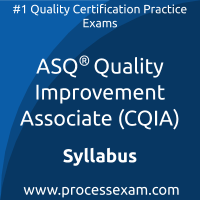 To achieve the professional designation of ASQ Certified Quality Improvement Associate from the ASQ, candidates must clear the CQIA Exam with the minimum cut-off score. For those who wish to pass the ASQ Quality Improvement Associate certification exam with good percentage, please take a look at the following reference document detailing what should be included in ASQ Quality Improvement Associate Exam preparation.
To achieve the professional designation of ASQ Certified Quality Improvement Associate from the ASQ, candidates must clear the CQIA Exam with the minimum cut-off score. For those who wish to pass the ASQ Quality Improvement Associate certification exam with good percentage, please take a look at the following reference document detailing what should be included in ASQ Quality Improvement Associate Exam preparation.
The ASQ CQIA Exam Summary, Body of Knowledge (BOK), Sample Question Bank and Practice Exam provide the basis for the real ASQ Certified Quality Improvement Associate (CQIA) exam. We have designed these resources to help you get ready to take ASQ Certified Quality Improvement Associate (CQIA) exam. If you have made the decision to become a certified professional, we suggest you take authorized training and prepare with our online premium ASQ Quality Improvement Associate Practice Exam to achieve the best result.
ASQ CQIA Exam Summary:
| Exam Name | ASQ Certified Quality Improvement Associate |
| Exam Code | CQIA |
| Exam Fee |
ASQ MEMBERS - USD $322 NON-MEMBERS - USD $422 RETAKES - USD $222 |
| Exam Duration |
Total appointment time- 210 Exam Time - 198 Minutes |
| Number of Questions | 110 |
| Passing Score | 550/750 |
| Format | Multiple Choice Questions |
| Books / Trainings | CQIA Handbook |
| Schedule Exam | Book Your Exam |
| Sample Questions | ASQ Quality Improvement Associate Exam Sample Questions and Answers |
| Practice Exam | ASQ Certified Quality Improvement Associate (CQIA) Practice Test |
ASQ Quality Improvement Associate Syllabus Topics:
| Topic | Details |
|---|---|
I. Quality Basics (30 Questions) |
|
| A. Terms, Concepts, and Principles |
1. Quality definitions 2. Quality plan 3. Quality systems 4. Organizational culture 5. Employee involvement and empowerment 6. Systems and processes 7. Variation 8. Standardization |
| B. Benefits of Quality |
- Describe how using quality tools, techniques, and concepts can improve processes and deliverables (including products and services), and how each benefit all parts of an organization. Describe what quality means to various stakeholders (e.g., employees, organizations, customers, suppliers, community, and interested parties) and how each can benefit from quality. (Understand) |
| C. Foundations of Quality |
- Understand the key concepts and teachings of the foundational quality thought leaders including 1) Walter Shewhart, 2) W. Edwards Deming, 3) Joseph Juran, 4) Kaoru Ishikawa, 5) Philip Crosby, and 6) Armand Feigenbaum. (Understand) |
II. Team Basics (16 Questions) |
|
| A. Team Organization |
1. Team purpose 2. Types of teams 3. Value of teams |
| B. Roles and Responsibilities |
- Describe the roles and responsibilities of various team stakeholders: (Understand) |
| C. Team Formation and Group Dynamics |
1. Initiating teams 2. Selecting team members 3. Team stages 4. Team conflict 5. Team decision-making |
III. Improvement (40 Questions) |
|
| A. Process Improvement |
1. Six Sigma concepts and tools 2. Lean concepts and tools 3. Benchmarking 4. Incremental and breakthrough improvement |
| B. Improvement Techniques |
- Select and utilize improvement opportunity techniques and/or methodologies: (Apply) |
| C. Improvement Tools |
- Select, interpret, and apply the basic improvement tools: (Apply) |
| D. Root Cause Analysis |
- Utilize root cause tools such as the 5 Whys and fishbone diagram to implement correction and corrective action. (Apply) |
| E. Risk Management |
- Understand the tools and techniques used to identify and communicate risks, including failure modes and effects analysis (FMEA) and Strengths, weaknesses, opportunities, threats (SWOT). Understand prioritization of activities and projects based on risk. (Understand) |
IV. Supplier Relationship (7 Questions) |
|
| A. Supplier selection |
- Identify the supplier selection criteria and approval process. (Remember) |
| B. Supplier relationship |
- Understand supplier relationships, associated challenges, and effects of a diverse supply base. (Understand) |
| C. Supplier Performance |
- Identify supplier performance measures, including quality performance, on-time delivery, and level of service. (Apply) |
V. Customer Relationship (7 Questions) |
|
| A. Customer Identification |
- Distinguish between internal and external customers. Describe their influence on products, services, and processes. (Understand) |
| B. Voice of the Customer (VOC) |
1. Data gathering and use 2. Complaint process 3. Customer needs |
Both ASQ and veterans who’ve earned multiple certifications maintain that the best preparation for a ASQ CQIA professional certification exam is practical experience, hands-on training and practice exam. This is the most effective way to gain in-depth understanding of ASQ Quality Improvement Associate concepts. When you understand techniques, it helps you retain ASQ Quality Improvement Associate knowledge and recall that when needed.
